Last updated on December 28, 2022
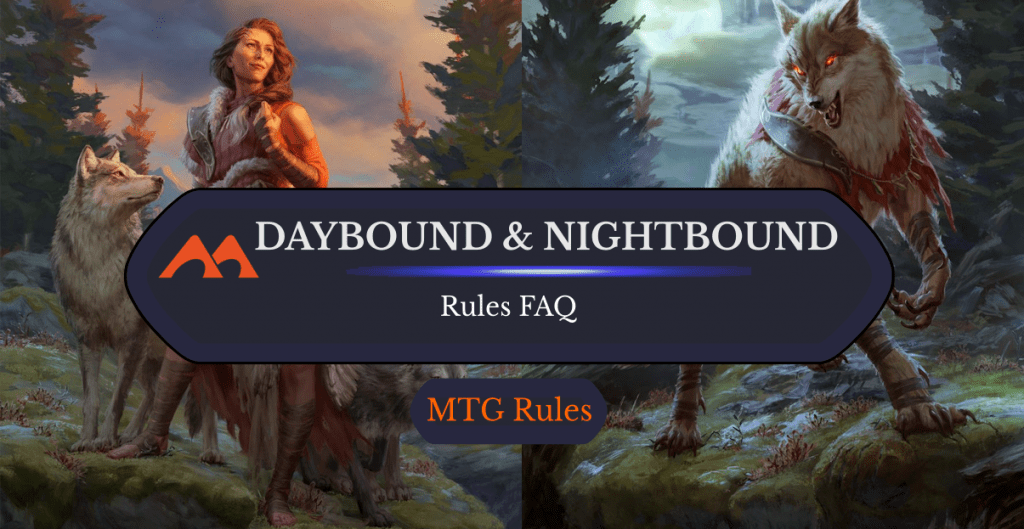
Arlinn, the Pack's Hope and Arlinn, the Moon's Fury | Illustrations by Anna Steinbauer
Midnight Hunt‘s release brought two new keywords for players to enjoy and debate the rules over: daybound and nightbound.
Even though there have been some werewolves outside of Innistrad, they’re most recognizable in the plane’s transforming dual-faced cards. Those who were around for the first Innistrad block remember how incredibly confusing it was to play them. Sometimes you’d end up with a battlefield where half of your cards transformed and half not. It was tiring having to constantly keep track of what needed to transform and what didn’t.
I actually built a Commander deck around them and it was very confusing to play. Maybe it’s because of all this experience I got with the old werewolves, but I find day and night to be much simpler. This wasn’t the case for everyone, though. Quite a lot of players said that the mechanic was too complex or too confusing.
Several set reviews mixed up the rulings during their first look at it, including those over at Limited Set Reviews. Hey, it happens to the best of us. I still think they’re an absolute high point in Magic design, though.
This is all well and good, but what even is daybound and nightbound? How does day and night work with transforming? I’m so glad you asked.
How Does Daybound/Nightbound Work?

It’s neither day nor night when the game starts. It becomes day whenever a card with “daybound” enters the battlefield. It also becomes day if a card like Gavony Dawnguard triggers it with an ability that says, “it becomes day when X happens.”
The day and night conditions care about how many spells the active player cast during the last turn. It becomes night the next turn if a player doesn’t cast any spells on their turn (this is daybound). It becomes day the next turn if a player casts at least two spells on their turn (this is nightbound).
If you’re still confused, let me put it a bit more clearly. As long as a card has applied the day/night cycle in the current game, you need to do the following check at the beginning of your upkeep:
- If it’s Day: If last turn’s player didn’t play any spells, it becomes night.
- If it’s Night: If last turn’s player played two or more spells, it becomes day.
Hopefully this made it a bit clearer.
When it comes to actually transforming your daybound/nightbound permanents, it’s incredibly simple. The daybound side is the “untransformed” human side, and this is up during the day. The “transformed” werewolf face is the nightbound side that roams around when it’s night.
A Brief History of Daybound and Nightbound
The Original Transform Mechanic
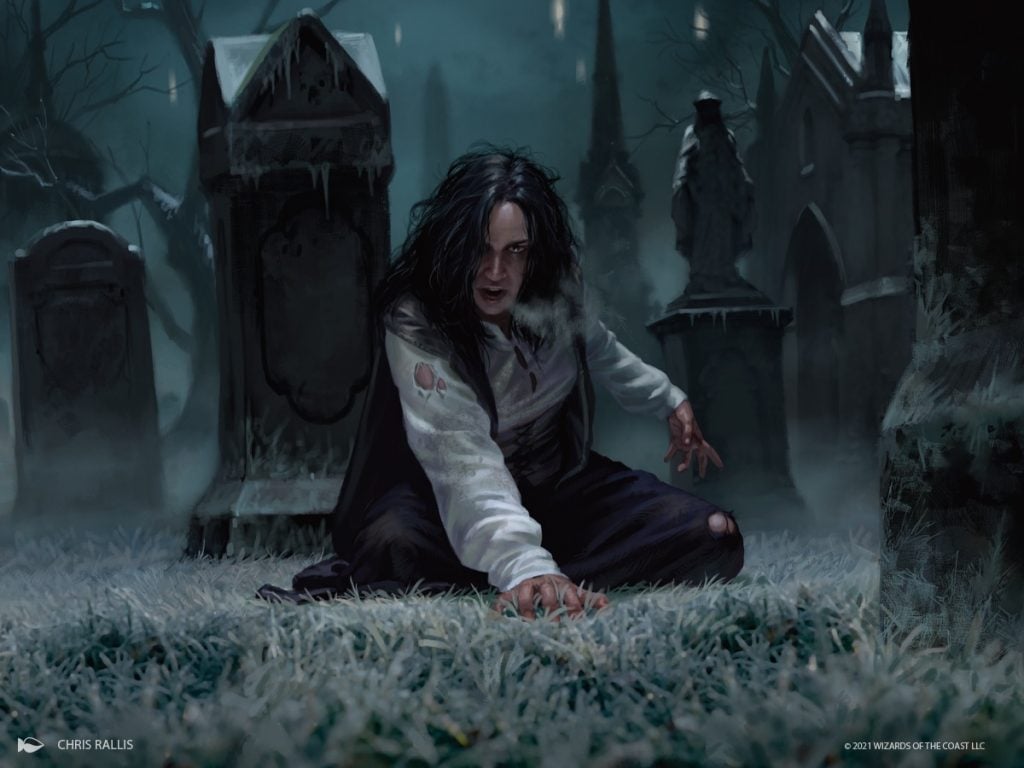
Graveyard Trespasser | Illustration by Chris Rallis
The first Innistrad werewolves didn’t have the daybound/nightbound keywords. They had two main rules that were present on all werewolves instead; the rule on the human side was that the card transformed at the start of your upkeep if no spells were played during the last turn; the werewolf rule said that it transformed back if two or more spells were played last turn.
The original transform mechanic applied to each werewolf individually, so you could end up with a field where half of your werewolves were transformed while half were still human. It also checked for any spells that were played, not just spells from the active player. This meant that any spell (say, from your opponent) could stop a transformation in its tracks.
This could very quickly spiral into a confusing board state. You had to keep track of what got played on each turn and you had to check which cards were supposed to transform during each upkeep. And clearly the people at Wizards noticed how this could get confusing.
Enter Daybound and Nightbound
Daybound and nightbound debuted with the release of Midnight Hunt in September 2021. Some of the first cards that we saw spoiled with the mechanic were Arlinn, the Pack's Hope and Tovolar, Dire Overlord, two impressive cards if you ask me.
But WotC planted the seeds for this a long time ago. One of the things that drew the most attention when the original Innistrad set released in September 2011 were the new transforming cards. Werewolves weren’t the only transforming cards (anyone who’s played against Delver of Secrets can attest to that), but they were definitely the highlight of the mechanic.
These kinds of werewolves appeared again in the Shadows Over Innistrad block in 2016. The ruling around their transformations remained the same. That brings us back to Midnight Hunt and the new day/night cycle. Even though the original transformation mechanic wasn’t exactly the same as the new daybound/nightbound mechanic, it’s the foundation on which it was built.
Some Clarifications on Daybound/Nightbound
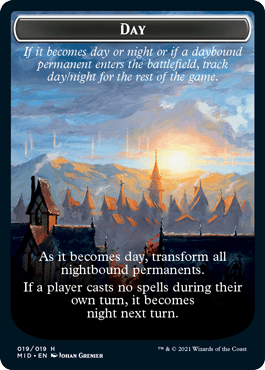

You Can’t Cast an End Step Instant to Prevent It
One of the main differences between this new condition and the way werewolves transformed before is that now you only care about what players play on their own turns. I’ve had a lot of situations where I chose not to cast any spells during my turn so I could transform my werewolves, only to have an opponent cast some instant like Opt to prevent it. It was a valid strategy and a way to play and whatnot, but it was also extremely boring.
You’re now protected with the new day and night mechanics. You’ll still curse under your breath every time your opponent casts the second spell on their turn, but it’s not as bad.
Entering the Battlefield at Night

I took it upon myself to build a werewolf deck as soon as Midnight Hunt released. I hadn’t really read up on this new mechanic so I was surprised that casting my werewolves at night had them enter the battlefield transformed.
Any daybound/nightbound card you play at night enters in its nightbound face. And with cards like Village Reavers on the board, having a bunch of werewolves come into play already transformed is particularly exciting.
When Does the Cycle End?
The cycle doesn't end. Once a card triggers the day and night cycle to start it goes on until the game ends. The only way to end it is by ending the game.
It Affects All Cards
One thing about this new mechanic that brings a fundamental change to the way a lot of cards (especially werewolves) are played is that the day and night conditions affect all creatures on the battlefield. You won’t have a handful of transformed werewolves and a handful of non-transformed humans on your field anymore and keeping track of what does and doesn’t transform is way easier.
Is Day Night a Trigger in MTG?
No, the day night cycle does not use the stack.. The status changes on the second part of the turn's untap step, before any player has been given priority. However, any abilities as a result of the change will occur at the next available point, which is the upkeep step.
Does the Nightbound Side of a Creature Trigger ETBs If It’s Night?

Spellrune Howler | Illustration by Lucas Graciano
If it’s night and you cast a daybound/nightbound creature, it enters the battlefield on its nightbound side. So any ETB effects that side of the card has definitely trigger. It also triggers ETB effects of other permanents already on the battlefield. The only abilities that don’t trigger because of this are any ETBs the card has on its daybound face.
What’s the Mana Value of a Nightbound Card?
The mana value of a nightbound card is the mana value on its front face — same as it was with the old werewolves. So your Tovolar, the Midnight Scourge doesn’t die to a Bloodchief's Thirst as long as it wasn’t kicked.
Can You Transform Daybound/Nightbound Cards a Different Way?
No, you can’t transform daybound/nightbound cards any other way. The idea behind this mechanic is that only the day and night cycle triggers transformations. Any other cards that transformed werewolves are now pretty much useless. As an avid fan of Moonmist, this makes me pretty sad.
Does Immerwolf Prevent Nightbound Cards from Transforming?
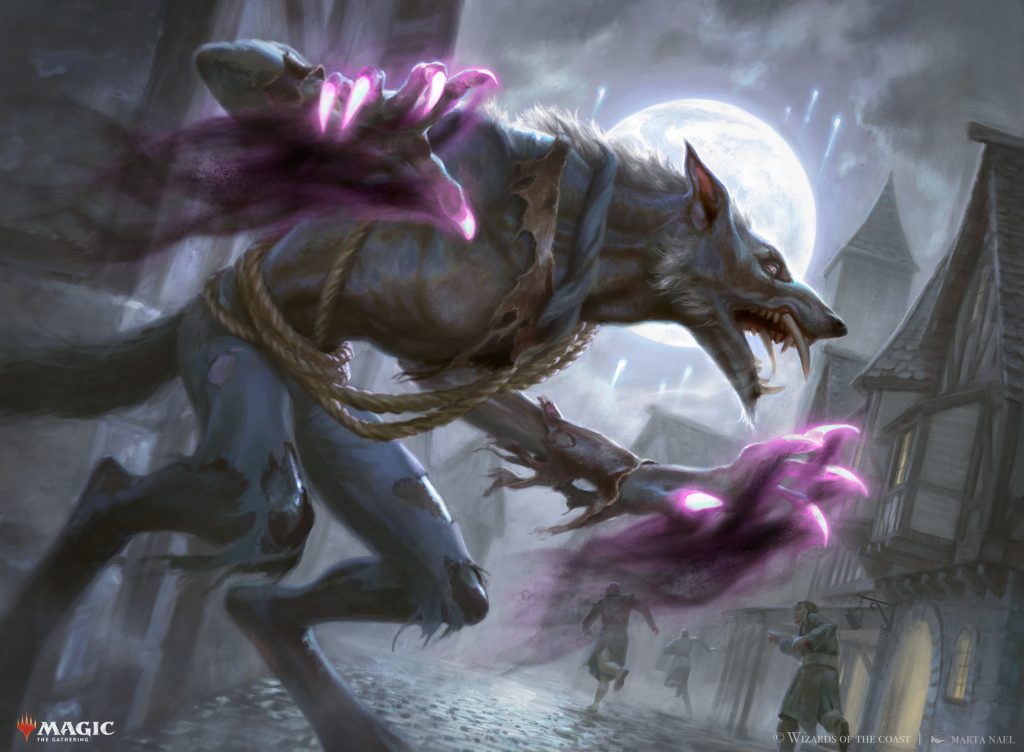
Baneclaw Marauder | Illustration by Marta Nael
Immerwolf works specifically with werewolves and not just nightbound cards but yes, this good wolf prevents your werewolves from transforming back when it’s day. The rules regarding daybound/nightbound state that the cards can’t transform any other way. Immerwolf just says that your non-human werewolves can’t transform at all. This ruling blocks the effect of daybound.
Are the Old Innistrad Werewolves Errataed to Use Day/Night?
I think that this is a bad choice but no, old werewolves aren’t gonna get errataed to work with the new mechanic. MaRo himself has said that he supported the idea of updating the old cards but it was eventually rejected.
I totally oppose the idea of not applying an errata to the old werewolves. With Commander being one of the most played formats in current Magic and werewolves finally getting a viable commander (no, Ulrich of the Krallenhorde is not a good commander for a werewolf tribal) it kinda sucks that old and new werewolves work in slightly different ways. If you’re playing with your friends you could ask them to just pretend like old werewolves were errata’d. But you’re gonna have to juggle a little bit if you want to use the old werewolves for tournaments or matches at your local game store.
This is probably the most disappointing thing about the mechanic. I love how it works and I think it’s a huge improvement on a tribe that was in dire need of some love. But not updating all the cards that came before,(which wouldn’t even be that many cards since werewolves showed up in just two blocks before) makes it really hard to build around them.
Daybound/Nightbound Card Gallery and List
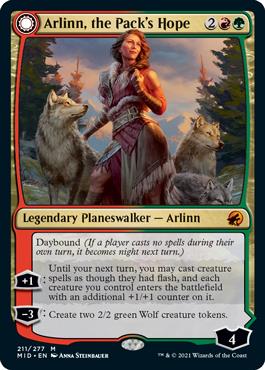

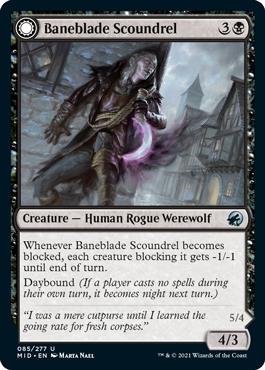
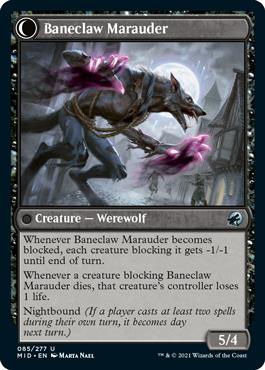

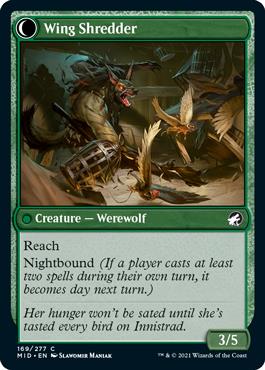
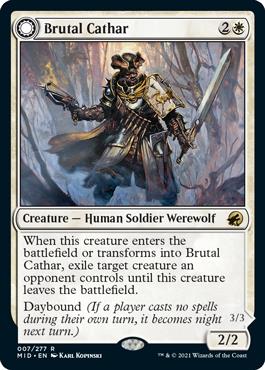

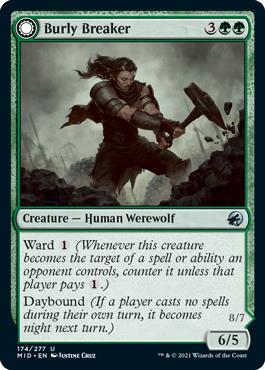
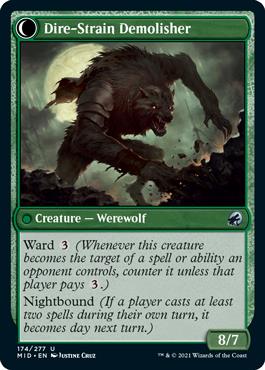
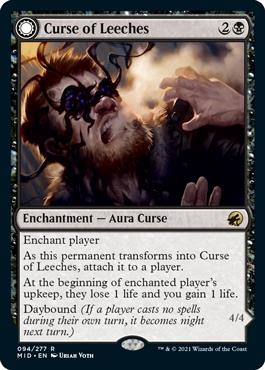
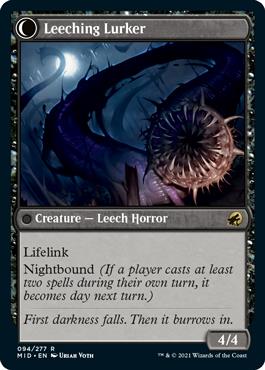

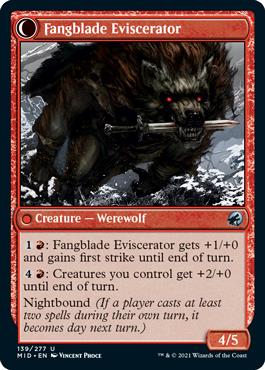
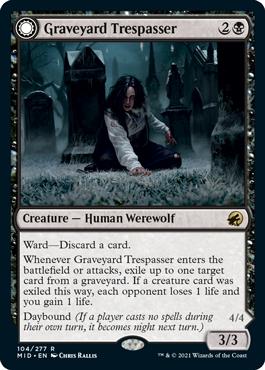


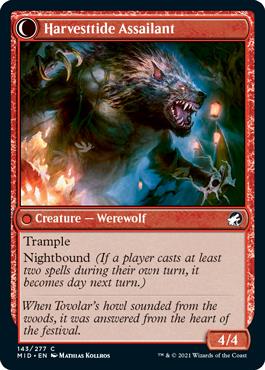
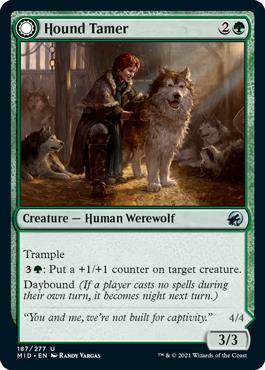
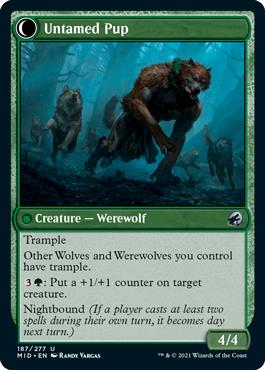
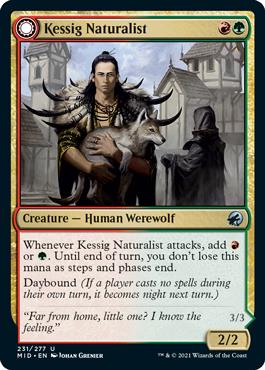
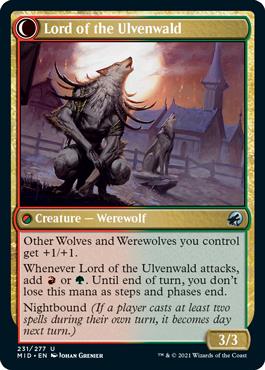
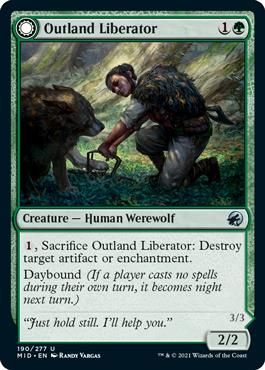
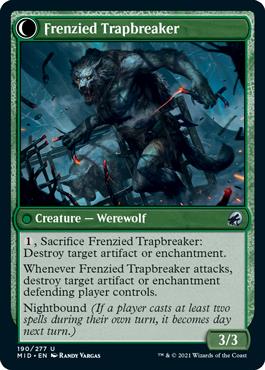
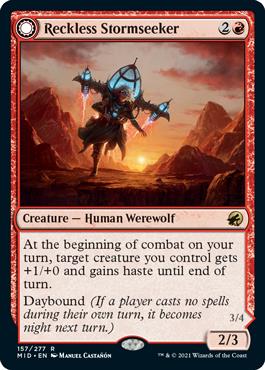
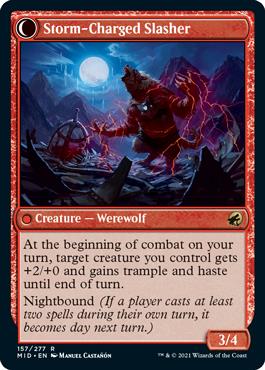
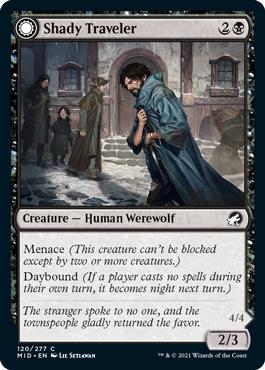
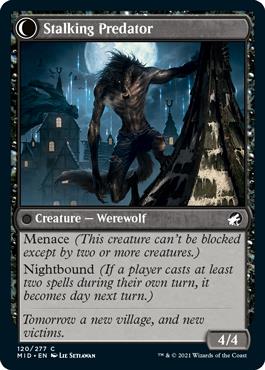
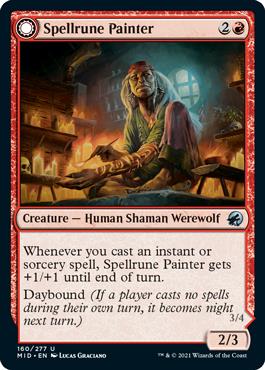
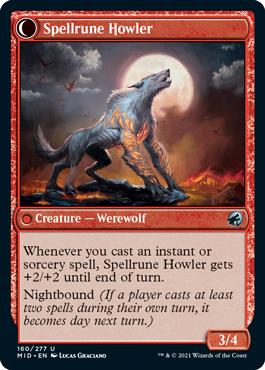
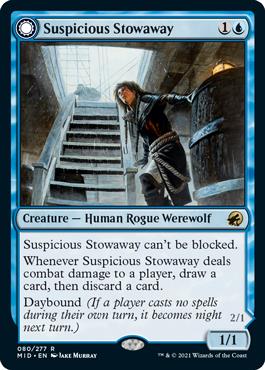
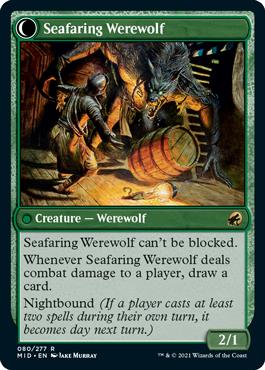

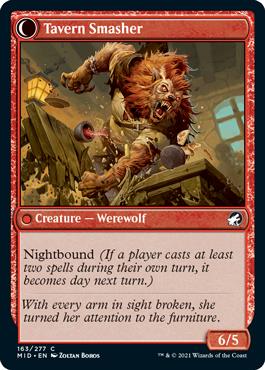


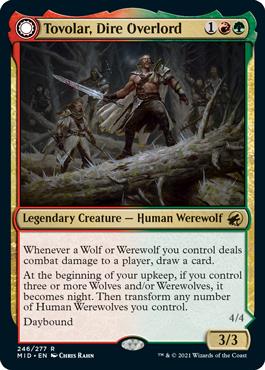

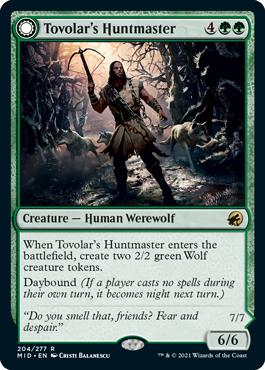
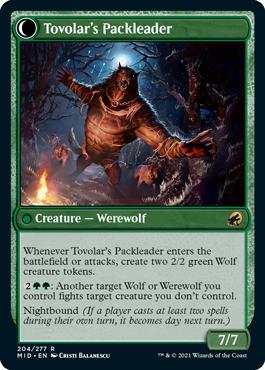
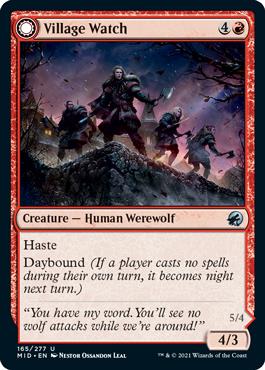
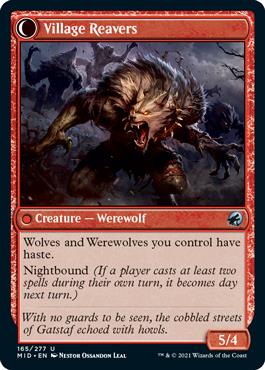
- Arlinn, the Pack's Hope / Arlinn, the Moon's Fury
- Baneblade Scoundrel / Baneclaw Marauder
- Bird Admirer / Wing Shredder
- Brutal Cathar / Moonrage Brute
- Burly Breaker / Dire-Strain Demolisher
- Curse of Leeches / Leeching Lurker
- Fangblade Brigand / Fangblade Eviscerator
- Graveyard Trespasser / Graveyard Glutton
- Harvesttide Infiltrator / Harvesttide Assailant
- Hound Tamer / Untamed Pup
- Kessig Naturalist / Lord of the Ulvenwald
- Outland Liberator / Frenzied Trapbreaker
- Reckless Stormseeker / Storm-Charged Slasher
- Shady Traveler / Stalking Predator
- Spellrune Painter / Spellrune Howler
- Suspicious Stowaway / Seafaring Werewolf
- Tavern Ruffian / Tavern Smasher
- Tireless Hauler / Dire-Strain Brawler
- Tovolar, Dire Overlord / Tovolar, the Midnight Scourge
- Tovolar's Huntmaster / Tovolar's Packleader
- Village Watch / Village Reavers
So You Wanna Play Werewolves
Werewolves may not be the best EDH tribe out there, but they’re carving a place for themselves in Standard with the rotation and the new Crimson Vowcards.
Here’s a quick werewolf decklist based on the one I myself play on Arena:
Planeswalker (4)
Creature (18)
Tovolar, Dire Overlord x4
Kessig Naturalist x4
Hound Tamer x2
Prosperous Innkeeper x4
Reckless Stormseeker x2
Outland Liberator x2
Instant (8)
Play with Fire x3
Cinderclasm x2
Demon Bolt x3
Sorcery (2)
Rabid Bite x2
Enchantment (4)
Ranger Class x2
In Search of Greatness x2
Land (24)
Cragcrown Pathway x4
Rockfall Vale x4
Mountain x8
Forest x8
I didn’t have a ton of wildcards when I built this deck so there’s definitely room for a lot of improvements. If you feel like using snow lands, cards like Frost Bite and Blizzard Brawl can replace Play with Fire and Rabid Bite.
You can also play around and see which werewolves fit into your strategy and which don’t. I’d say the most important ones to always have are Tovolar, Dire Overlord, Kessig Naturalist, and Arlinn, the Pack's Hope. Out of all the games I’ve played so far with the deck, those three have proven to be the backbone that keeps everything else running.
New Or Old — Which Is Better?

Tovolar, the Midnight Scourge | Illustration by Chris Rahn
Time to have an opinion, I guess. I like day/night way more than the original transform mechanic. I enjoyed playing them and I still think of rebuilding my werewolf Commander deck from time to time, but the truth is that transforming all my werewolves and having to go one by one every upkeep was boring and tedious.
I think the old werewolf mechanic was a diamond in the rough in terms of design. It took the transforming cards from Kamigawa like Akki Lavarunner and made a design that was cleaner, easier to understand, and more fun to play. It also felt completely on-theme with the werewolf creature type. Having the front and back sides be day and night respectively with a “unifying” condition to transform all your creatures was mechanically solid and particularly flavorful.
But it also had some issues. Let’s say you controlled a couple werewolves and they all transformed. You play a single werewolf on your next turn so it enters the battlefield and remains a human during the next upkeep. Your opponent plays a single spell. The same thing happens during the next upkeep.
At some point you’d have quite a few transformed werewolves and quite a few non-transformed ones and you’d have to keep track of them every upkeep. If there was a turn where no one played any spells or someone played two, you’d go card by card seeing what transformed and what didn’t.
This usually ends up taking time out of the game. Checking transformations end up taking a lot of the effort you could’ve put into playing the game. That’s also not great for flavor. Why is it night for some and day for others? Kind of weird to say the least.
This is where I think the new day/night condition works a lot better. The main mechanic is there; It becomes night if a player casts no spells on their turns and it’s day against if a player casts two or more spells on their turn. It’s simple and it works, and now it applies to all daybound/nightbound permanents, werewolves and otherwise.
Having the day/night cycle be a condition that affects all the permanents on the field makes more sense than it being an individual thing. This also allowed the designs of Midnight Hunt to explore the possibility of permanents that change during night and day that aren’t werewolves, like Curse of Leeches. There’s also the possibility of having cards that have effects related to the cycle without necessarily being daybound/nightbound themselves.
I personally prefer the new cycle over the original mechanic. The fact that it only cares about the active player is a really strong selling point for me, plus affecting all of your werewolves. It makes playing the tribe a lot easier and more fun while still keeping the core idea behind the mechanic.
Wrap Up
I absolutely love Magic’s werewolves. The original Innistrad block came out right around when I started going to my LGS and I was immediately hooked. I love anything and everything relating to gothic horror and werewolves are arguably my favorite monster. No, I’m not a furry.
I’ve had a werewolf tribal deck since they first came out and it remains one of my favorites, even if it’s a bit of a pain to play with sometimes. I’m really happy with the new day/night mechanic because it’ll make playing werewolves a lot easier going forward. I just wish they’d errata all the old ones so I can build a proper EDH deck. Maybe one day they will.
What do you think? Do you like this mechanic? I’ve heard that a lot of players still find it too confusing so hopefully this clears things up a little bit. Feel free to leave a comment down below telling me what you think about day and night or werewolves! And make sure to check out our blog and our Twitter for more content like this.
That’s all from me for now. Happy spooky month, have a good one, and happy hunting!
Follow Draftsim for awesome articles and set updates: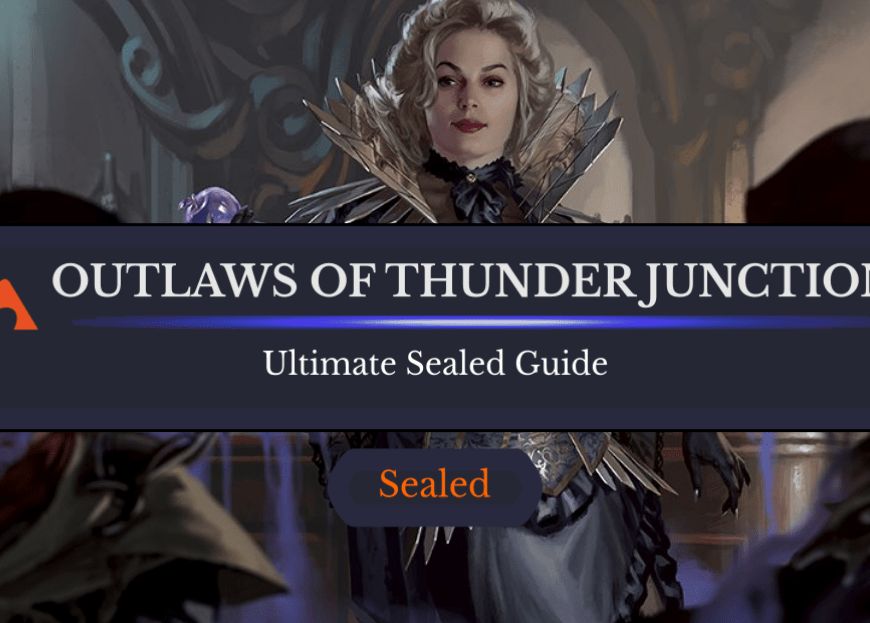

Add Comment